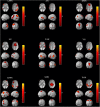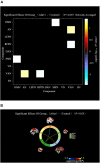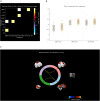Networks Are Associated With Acupuncture Treatment in Patients With Diarrhea-Predominant Irritable Bowel Syndrome: A Resting-State Imaging Study
- PMID: 34720908
- PMCID: PMC8551866
- DOI: 10.3389/fnhum.2021.736512
Networks Are Associated With Acupuncture Treatment in Patients With Diarrhea-Predominant Irritable Bowel Syndrome: A Resting-State Imaging Study
Abstract
Background: Irritable Bowel Syndrome (IBS), as a functional gastrointestinal disorder, is characterized by abdominal pain and distension. Recent studies have shown that acupuncture treatment improves symptoms of diarrhea-predominant irritable bowel syndrome (IBS-D) by altering networks in certain brain regions. However, few studies have used resting-state functional magnetic resonance imaging (fMRI) to compare altered resting-state inter-network functional connectivity in IBS-D patients before and after acupuncture treatment. Objective: To analyze altered resting-state inter-network functional connectivity in IBS-D patients before and after acupuncture treatment. Methods: A total of 74 patients with IBS-D and 31 healthy controls (HCs) were recruited for this study. fMRI examination was performed in patients with IBS-D before and after acupuncture treatment, but only at baseline in HCs. Data on the left frontoparietal network (LFPN), default mode network (DMN), salience network (SN), ventral attention network (VAN), auditory network (AN), visual network (VN), sensorimotor network (SMN), dorsal attention network (DAN), and right frontoparietal network (RFPN) were subjected to independent component analysis (ICA). The functional connectivity values of inter-network were explored. Results: Acupuncture decreased irritable bowel syndrome symptom severity score (IBS-SSS) and Hamilton Anxiety Scale (HAMA). It also ameliorated symptoms related to IBS-D. Notably, functional connectivity between AN and VAN, SMN and DMN, RFPN and VAN in IBS-D patients after acupuncture treatment was different from that in HCs. Furthermore, there were differences in functional connectivity between DMN and DAN, DAN and LFPN, DMN and VAN before and after acupuncture treatment. The inter-network changes in DMN-VAN were positively correlated with changes in HAMA, life influence degree, and IBS-SSS in IBS-D. Conclusion: Altered inter-network functional connectivity is involved in several important hubs in large-scale networks. These networks are altered by acupuncture stimulation in patients with IBS-D.
Keywords: acupuncture; fMRI; functional connectivity; independent component analysis; irritable bowel syndrome; mechanism.
Copyright © 2021 Zhao, Pei, Ning, Guo, Song, Zhou, Chen, Sun and Mi.
Conflict of interest statement
The authors declare that the research was conducted in the absence of any commercial or financial relationships that could be construed as a potential conflict of interest.
Figures






Similar articles
-
[Mind-regulating and spleen-strengthening needling technique improves abdominal hypersensitivity and emotion by enhancing functional connectivity between hippocampus and brain regions in diarrhea-predominant irritable bowel syndrome patients].Zhen Ci Yan Jiu. 2021 Apr 25;46(4):318-25. doi: 10.13702/j.1000-0607.200569. Zhen Ci Yan Jiu. 2021. PMID: 33931998 Chinese.
-
Effect of Acupuncture Stimulation of Hegu (LI4) and Taichong (LR3) on the Resting-State Networks in Alzheimer's Disease: Beyond the Default Mode Network.Neural Plast. 2021 Mar 8;2021:8876873. doi: 10.1155/2021/8876873. eCollection 2021. Neural Plast. 2021. PMID: 33747074 Free PMC article.
-
Aberrant functional connectivity within and between brain networks in patients with early-onset bipolar disorder.J Affect Disord. 2023 Oct 1;338:41-51. doi: 10.1016/j.jad.2023.05.057. Epub 2023 May 29. J Affect Disord. 2023. PMID: 37257780
-
A multi-omic brain gut microbiome signature differs between IBS subjects with different bowel habits.Neuropharmacology. 2023 Mar 1;225:109381. doi: 10.1016/j.neuropharm.2022.109381. Epub 2022 Dec 17. Neuropharmacology. 2023. PMID: 36539012 Free PMC article. Review.
-
Acupuncture and related therapies for the anxiety and depression in irritable bowel syndrome with diarrhea (IBS-D): A network meta-analysis of randomized controlled trials.Front Psychiatry. 2022 Dec 23;13:1067329. doi: 10.3389/fpsyt.2022.1067329. eCollection 2022. Front Psychiatry. 2022. PMID: 36620677 Free PMC article.
Cited by
-
Neuroimaging studies of acupuncture on Alzheimer's disease: a systematic review.BMC Complement Med Ther. 2023 Feb 23;23(1):63. doi: 10.1186/s12906-023-03888-y. BMC Complement Med Ther. 2023. PMID: 36823586 Free PMC article.
-
Neuroplasticity of the white matter tracts underlying recovery of diarrhea-predominant irritable bowel syndrome following acupuncture treatment.Front Neurosci. 2024 Sep 19;18:1383041. doi: 10.3389/fnins.2024.1383041. eCollection 2024. Front Neurosci. 2024. PMID: 39364438 Free PMC article.
-
Electroacupuncture ameliorates visceral hypersensitivity and negative emotions by regulating paraventricular hypothalamic nucleus and colonic corticotropin-releasing factor signaling.World J Psychiatry. 2025 Aug 19;15(8):107342. doi: 10.5498/wjp.v15.i8.107342. eCollection 2025 Aug 19. World J Psychiatry. 2025. PMID: 40837817 Free PMC article.
-
Comparisons of different electrical stimulation modalities for treating visceral pain in a rodent model of irritable bowel syndrome.Bioelectron Med. 2024 Nov 11;10(1):27. doi: 10.1186/s42234-024-00158-1. Bioelectron Med. 2024. PMID: 39523376 Free PMC article.
-
Association between patent foramen ovale and migraine: evidence from a resting-state fMRI study.Brain Imaging Behav. 2024 Aug;18(4):720-729. doi: 10.1007/s11682-024-00868-9. Epub 2024 Feb 21. Brain Imaging Behav. 2024. PMID: 38381323 Free PMC article.
References
LinkOut - more resources
Full Text Sources
Miscellaneous

